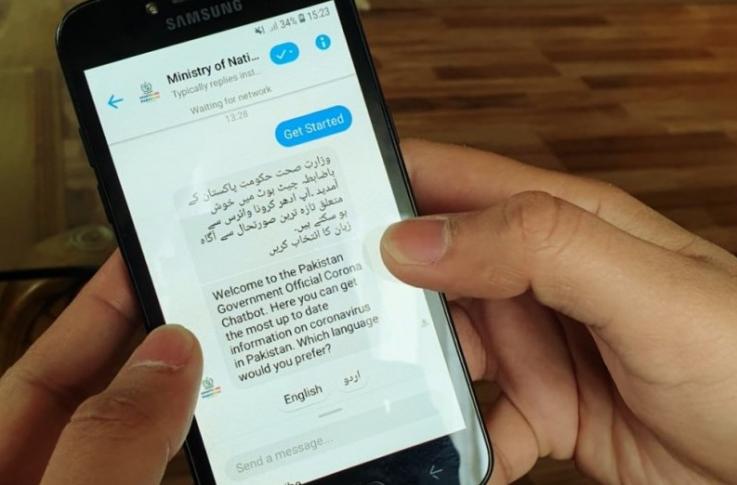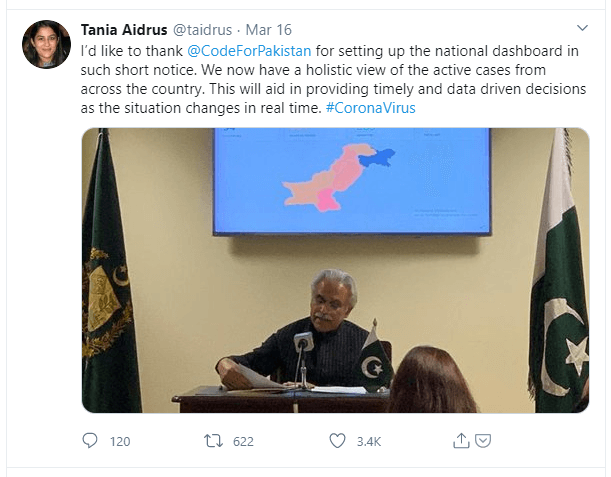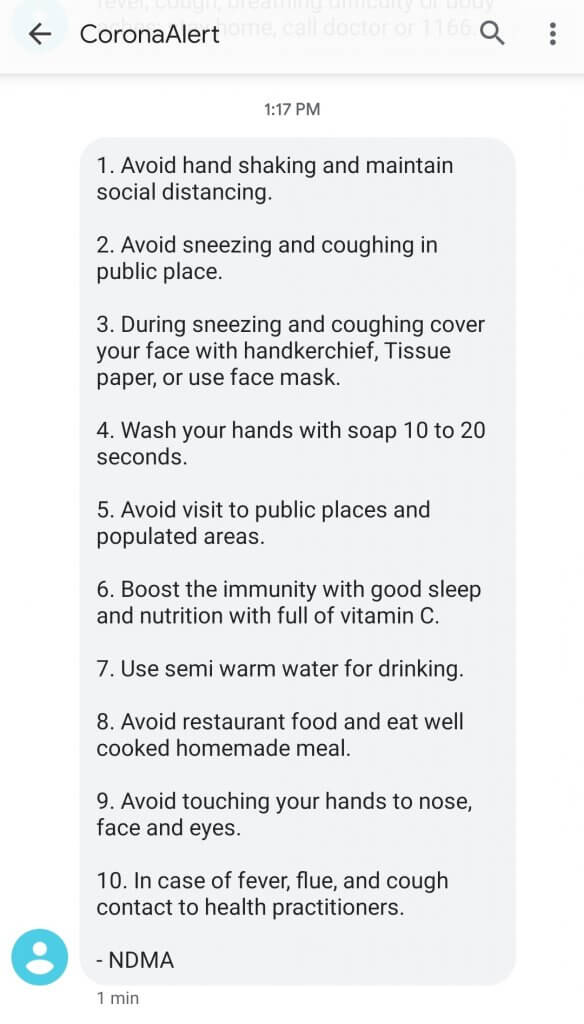
This article was originally published on the website of Digital Rights Monitor, an initiative of Media Matters for Democracy, an APC member organisation in Pakistan.
As governments around the world attempt to flatten the curve of coronavirus cases, authorities appear to be looking towards technology for support.
Chatbots, online dashboards, and mobile caller tunes are just some of the digital strategies put on display by officials to raise awareness about testing, precautionary measures, and the impact of Covid-19 — the disease caused by the novel coronavirus.
In Pakistan, the head of the government’s flagship digital programme is supporting the health ministry’s efforts.
Tania Aidrus, Special Assistant to the Prime Minister on Digital Pakistan, said they looked at the measures taken by countries that have slowed down the spread of the virus and noticed some important things.
“One of the things is actually having a handle on the data of the cases and then using that data to understand how the cases are rising,” Ms. Aidrus said in a television talk show appearance on 17 March. “(This way, we can) have a real-time understanding of the situation on the ground.”
She said they were working on systems that could facilitate health officials to get access to real-time data of coronavirus cases.
On 19 March, the government launched a public web portal that provides the summary of domestic coronavirus cases along with information on prevention and testing. Earlier, the National Institute of Health was publishing daily situation reports on its website.

A screenshot of the official web portal on coronavirus in Pakistan. Screenshot taken at 6:00 p.m. on 20 March.
In the days leading up to the launch of the portal and since, the government has relied on support from private technology companies and civic-tech groups, which volunteered their time and technical resources. Ms. Aidrus called these volunteers a “godsend”.
One such group is the technology non-profit, Code for Pakistan.
Volunteers step up
Ebtihaj Khan, the Government Innovation Lead at Code for Pakistan, said they were keen to offer assistance to the government.
“As soon as we heard efforts were about to get underway, we reached out to the Digital Pakistan team and said we’re here to help as volunteers,” Mr. Khan said.
Their initial discussions were on data collection and distribution.
“Our first and foremost focus was on information dissemination (about coronavirus cases),” Mr. Khan said. “So that accurate information was made available on time.”
He and his colleagues set up a temporary data dashboard for the government officials to view the nationwide cases of Covid-19. Mr. Khan clarified that this initial dashboard was for internal use only. It was never made public and should not be confused with private and unofficial efforts that were shared on social media.
“Later the National Information Technology Board took charge and launched a separate official portal,” Mr. Khan said. “We are now helping with future planning.”
He said they have presented a plan to the government with immediate, short-term, and long-term steps regarding the coronavirus. They have suggested immediate measures to identify clusters of infected individuals and determine which areas might be at a higher risk for the spread. The short and long term actions deal with translation of awareness messages in local languages, mapping of relevant healthcare facilities and medical supplies, support for people in lockdown, monitoring of recovered patients, and steps to mitigate economic fallout.
Mr. Khan said it is now up to the government how it chooses to utilise the recommendations.

Tania Aidrus praised Code for Pakistan in a tweet on 16 March. The dashboard created by Code for Pakistan was temporary and for internal use only and should not be confused with the official Covid-19 portal launched on Thursday.
The government’s Covid-19 portal has received some criticism on Twitter for its technical aspects and English content. There was also debate in the country on Friday after prayer congregations went ahead despite government requests for social distancing, indicating that perhaps coronavirus awareness messages were not finding the widespread ownership that is necessary to reduce the spread of the virus.
But during her TV interview, Ms. Aidrus had said discussions are going on about making the coronavirus advisories available in regional languages, developing audio messages for those who cannot read, and initiating robo-calls to proactively spread coronavirus awareness. She had also hinted at the potential release of location data to warn people about infection “hot spots” in Pakistan.
“At this point, our work should be to provide accurate and verified information to people through whichever means possible,” Ms. Aidrus said.
The Facebook Messenger chatbot developed for the health ministry is a step in this direction.
Not all bots are bad
The chatbot was developed for the Digital Pakistan team by Botsify. It was launched on Sunday for the general public. It can be accessed through Facebook Messenger via this direct link.
The chatbot provides guidance in Urdu and English. An interactive menu provides options for users to learn about the coronavirus, its symptoms, and protective measures. Users can also assess their risk of infection by answering a series of yes-or-no questions. Information on testing facilities in 10 Pakistani cities is also provided.

Screenshot of the National Health Services, Regulations and Coordination chatbot developed by Botsify.
After Ms. Aidrus announced the chatbot in a tweet on 16 March, the service received around 15,000 messages in a day, according to a blog post by the Botsify team. In the TV show, Ms. Aidrus said the chatbot’s performance will be improved through an “iterative process” based on the queries posed by users.
Over the weekend, the National Disaster Management Authority that is leading the coronavirus operations in Pakistan issued an SMS alert to mobile phone subscribers. The text message contained general precautions for the public. The message is also in the English language, according to a copy available with the Digital Rights Monitor.
It is likely that more updates will follow in the days to come.

The SMS alert sent by the National Disaster Management Authority for awareness about coronavirus precautionary measures.
Mr. Khan of Code for Pakistan said he was also in touch with Code for All, the international network of which the Pakistani non-profit is a member.
“We have talked about sharing examples to see what lessons we can learn from other countries regarding coronavirus and what advice we can share based on our use of technology,” he said.
Across the globe, officials are looking at technology solutions to supplement healthcare systems.
Novel strategies for a novel virus
From the traditional to the innovative, different governments have used diverse ways to deploy technology in their efforts against Covid-19.
In neighbouring India, the department of telecommunications has asked cell phone operators to run coronavirus awareness messages in place of the regular caller tunes. The Indian state of Punjab also launched a smartphone app to share advisories with residents.
Saudi Arabia has focussed on training. The Saudi Red Crescent Authority has used online sessions to train nearly 7,500 individuals for coronavirus control and prevention.
The government of Canada has followed a straightforward approach. It published a coronavirus awareness web page with infographics and specialised instructions, and pledged millions of dollars for coronavirus medical research. Singapore’s ministry of health is managing a comprehensive web portal. Meanwhile, Japanese broadcaster NHK launched a virus information portal and is now preparing special programming for people in self-isolation and coronavirus lockdown.
Several automated technology and AI solutions have been used in China reportedly to help against coronavirus spread. However, privacy concerns remain about the use of Chinese surveillance tech infrastructure to keep track of suspected cases. Elsewhere, South Korea, which has tested hundreds of thousands of its citizens for the virus, has used cellphone alerts. The alerts not only distribute general advice but also share the specific movements of people who tested positive. This may have helped with the containment of the spread, but it also led to public speculation and stigma in some cases.
The latest addition to these efforts is the World Health Organization’s WhatsApp chatbot that can be accessed at +41 79 893 18 92.